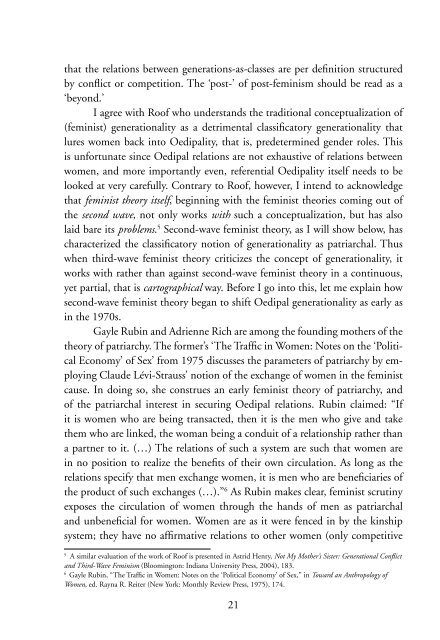Teaching with the third wave new feminists - MailChimp
Teaching with the third wave new feminists - MailChimp
Teaching with the third wave new feminists - MailChimp
You also want an ePaper? Increase the reach of your titles
YUMPU automatically turns print PDFs into web optimized ePapers that Google loves.
that <strong>the</strong> relations between generations-as-classes are per definition structuredby conflict or competition. The ‘post-’ of post-feminism should be read as a‘beyond.’I agree <strong>with</strong> Roof who understands <strong>the</strong> traditional conceptualization of(feminist) generationality as a detrimental classificatory generationality thatlures women back into Oedipality, that is, predetermined gender roles. Thisis unfortunate since Oedipal relations are not exhaustive of relations betweenwomen, and more importantly even, referential Oedipality itself needs to belooked at very carefully. Contrary to Roof, however, I intend to acknowledgethat feminist <strong>the</strong>ory itself, beginning <strong>with</strong> <strong>the</strong> feminist <strong>the</strong>ories coming out of<strong>the</strong> second <strong>wave</strong>, not only works <strong>with</strong> such a conceptualization, but has alsolaid bare its problems. 5 Second-<strong>wave</strong> feminist <strong>the</strong>ory, as I will show below, hascharacterized <strong>the</strong> classificatory notion of generationality as patriarchal. Thuswhen <strong>third</strong>-<strong>wave</strong> feminist <strong>the</strong>ory criticizes <strong>the</strong> concept of generationality, itworks <strong>with</strong> ra<strong>the</strong>r than against second-<strong>wave</strong> feminist <strong>the</strong>ory in a continuous,yet partial, that is cartographical way. Before I go into this, let me explain howsecond-<strong>wave</strong> feminist <strong>the</strong>ory began to shift Oedipal generationality as early asin <strong>the</strong> 1970s.Gayle Rubin and Adrienne Rich are among <strong>the</strong> founding mo<strong>the</strong>rs of <strong>the</strong><strong>the</strong>ory of patriarchy. The former’s ‘The Traffic in Women: Notes on <strong>the</strong> ‘PoliticalEconomy’ of Sex’ from 1975 discusses <strong>the</strong> parameters of patriarchy by employingClaude Lévi-Strauss’ notion of <strong>the</strong> exchange of women in <strong>the</strong> feministcause. In doing so, she construes an early feminist <strong>the</strong>ory of patriarchy, andof <strong>the</strong> patriarchal interest in securing Oedipal relations. Rubin claimed: “Ifit is women who are being transacted, <strong>the</strong>n it is <strong>the</strong> men who give and take<strong>the</strong>m who are linked, <strong>the</strong> woman being a conduit of a relationship ra<strong>the</strong>r thana partner to it. (…) The relations of such a system are such that women arein no position to realize <strong>the</strong> benefits of <strong>the</strong>ir own circulation. As long as <strong>the</strong>relations specify that men exchange women, it is men who are beneficiaries of<strong>the</strong> product of such exchanges (…).” 6 As Rubin makes clear, feminist scrutinyexposes <strong>the</strong> circulation of women through <strong>the</strong> hands of men as patriarchaland unbeneficial for women. Women are as it were fenced in by <strong>the</strong> kinshipsystem; <strong>the</strong>y have no affirmative relations to o<strong>the</strong>r women (only competitive5A similar evaluation of <strong>the</strong> work of Roof is presented in Astrid Henry, Not My Mo<strong>the</strong>r’s Sister: Generational Conflictand Third-Wave Feminism (Bloomington: Indiana University Press, 2004), 183.6Gayle Rubin, “The Traffic in Women: Notes on <strong>the</strong> ‘Political Economy’ of Sex,” in Toward an Anthropology ofWomen, ed. Rayna R. Reiter (New York: Monthly Review Press, 1975), 174.21
















